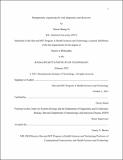Medical Engineering and Medical Physics: Metagenomic Sequencing for Viral Diagnostics and Discovery
Author(s)
Ye, Simon Huang
DownloadThesis PDF (9.689Mb)
Advisor
Sabeti, Pardis
Terms of use
Metadata
Show full item recordAbstract
The application of metagenomic sequencing is transforming microbiology by directly interrogating the entire community composition of a clinical sample in an unbiased manner, reducing reliance on culture-dependent approaches. In concert with the advent of next generation sequencing (NGS) technologies that interrogate extremely large quantities of genetic information on the order of billions to trillions of base pairs per sequencing run, computational approaches are necessary for storing and processing the vast quantity of NGS data into useful biological information. Here we benchmark the performance of metagenomic sequence classification methods, controlling for database differences by using a uniform database. Additionally, we developed an integrated metagenomic NGS (mNGS) computational pipeline incorporating stringent negative controls for the primary diagnosis of a cohort of patients with encephalitis with clinical suspicion of viral infection. These methods were used to interrogate secondary coinfections in patient cohorts with primary HIV and Lassa infection.
Metagenomic sequencing can also be utilized to perform large scale screening for the directed evolution of viral vectors. Adeno-associated virus (AAV) is a non-pathogenic virus that infects humans and commonly used as a vector for gene therapy. However, natural AAV serotypes tend to accumulate in the liver, leading to toxic side-effects when higher doses are used to transduce non-liver tissues. In this work, we engineer specific amino acids on the viral capsid of AAV9 and use sequencing to screen millions of viral capsid variants to evolve an engineered AAV with up to 100 times higher muscle tissue specificity over natural AAV.
Date issued
2022-02Department
Harvard-MIT Program in Health Sciences and TechnologyPublisher
Massachusetts Institute of Technology